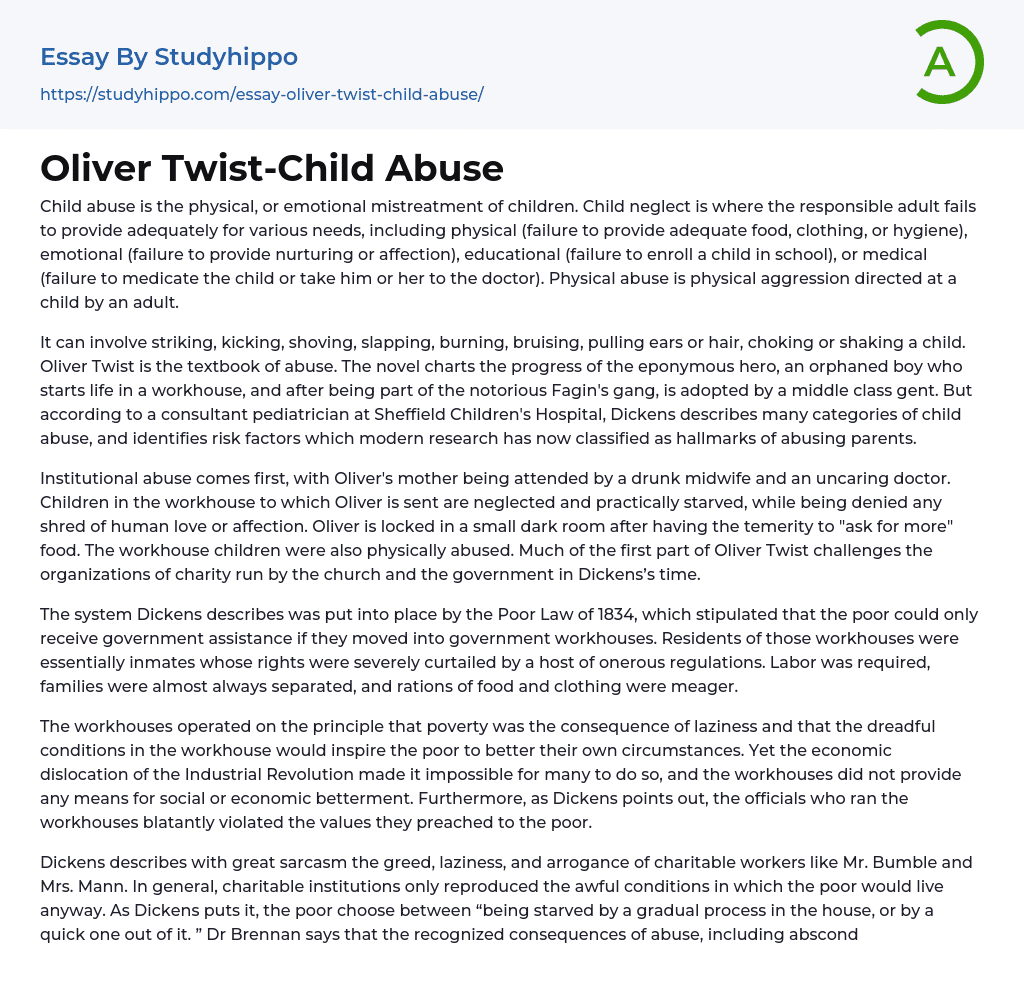Child abuse is the physical, or emotional mistreatment of children. Child neglect is where the responsible adult fails to provide adequately for various needs, including physical (failure to provide adequate food, clothing, or hygiene), emotional (failure to provide nurturing or affection), educational (failure to enroll a child in school), or medical (failure to medicate the child or take him or her to the doctor). Physical abuse is physical aggression directed at a child by an adult.
It can involve striking, kicking, shoving, slapping, burning, bruising, pulling ears or hair, choking or shaking a child. Oliver Twist is the textbook of abuse. The novel charts the progress of the eponymous hero, an orphaned boy who starts life in a workhouse, and after being part of the notorious Fagin's gang, is adopted by a middle class gent. But
...according to a consultant pediatrician at Sheffield Children's Hospital, Dickens describes many categories of child abuse, and identifies risk factors which modern research has now classified as hallmarks of abusing parents.
Institutional abuse comes first, with Oliver's mother being attended by a drunk midwife and an uncaring doctor. Children in the workhouse to which Oliver is sent are neglected and practically starved, while being denied any shred of human love or affection. Oliver is locked in a small dark room after having the temerity to "ask for more" food. The workhouse children were also physically abused. Much of the first part of Oliver Twist challenges the organizations of charity run by the church and the government in Dickens’s time.
The system Dickens describes was put into place by the Poor Law of 1834, whic
stipulated that the poor could only receive government assistance if they moved into government workhouses. Residents of those workhouses were essentially inmates whose rights were severely curtailed by a host of onerous regulations. Labor was required, families were almost always separated, and rations of food and clothing were meager.
The workhouses operated on the principle that poverty was the consequence of laziness and that the dreadful conditions in the workhouse would inspire the poor to better their own circumstances. Yet the economic dislocation of the Industrial Revolution made it impossible for many to do so, and the workhouses did not provide any means for social or economic betterment. Furthermore, as Dickens points out, the officials who ran the workhouses blatantly violated the values they preached to the poor.
Dickens describes with great sarcasm the greed, laziness, and arrogance of charitable workers like Mr. Bumble and Mrs. Mann. In general, charitable institutions only reproduced the awful conditions in which the poor would live anyway. As Dickens puts it, the poor choose between “being starved by a gradual process in the house, or by a quick one out of it. ” Dr Brennan says that the recognized consequences of abuse, including absconding, passivity, depression, poor self image and vulnerability to corruption by anyone showing them what appears to be love, are very well illustrated by the text.
Dickens also managed to identify all the now accepted parental risk factors for abuse: substance abuse, including alcohol, domestic violence, mental health problems and animal abuse. And he also describes the domestic abuse perpetrated against both sexes in the novel. Nancy is abused by Bill Sykes her
pimp and Mr. Bumble is abused by Mrs. Coney, the superintendent of the female workhouse, two months after their marriage.
- Child essays
- Child labor essays
- Childcare essays
- Abuse Support essays
- Alcohol Abuse essays
- Child Abuse essays
- Physical Abuse essays
- Sexual Abuse essays
- Substance Abuse essays
- 1984 essays
- A Farewell to Arms essays
- A Good Man Is Hard to Find essays
- A Hanging essays
- A Lesson Before Dying essays
- A Long Way Gone essays
- A Rose For Emily essays
- A Separate Peace essays
- A Tale Of Two Cities essays
- A Very Old Man With Enormous Wings essays
- Adventures Of Huckleberry Finn essays
- Alice in Wonderland essays
- All Quiet on The Western Front essays
- Allegory of the Cave essays
- An occurrence at owl creek bridge essays
- Animal Farm essays
- Anthem essays
- Antigone essays
- Arthur Conan Doyle essays
- As I Lay Dying essays
- Atticus Finch essays
- Barn Burning essays
- Battle Royal essays
- Beauty and The Beast essays
- Beloved essays
- Boo Radley essays
- Brave New World essays
- Candide essays
- Castle essays
- Characters In Hamlet essays
- Characters In Romeo And Juliet essays
- Christmas carol essays
- Chronicle of a Death Foretold essays
- Cinderella essays
- Crime and Punishment essays
- Daisy Miller essays
- Death of a Salesman American Dream essays
- Desdemona essays
- Diary Of A Wimpy Kid essays
- Dracula essays
- Dubliners essays




